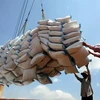International meat producers have revealed their intent to take over the market in Vietnam following a surge in domestic demand, the Phap luat (Law) Newspaper has reported.
In March, a Canadian delegation, led by the country’s Minister of Agriculture and Agrifood Gerry Ritz, visited Vietnam in a bid to promote safe, high-quality beef among local restaurants and hotel chains.
On April 20, the European Livestock and Meat Trades Union and the Polish Union of Producers and Employers of the Meat Industry coordinated a press conference presenting European beef and pork. As a Vietnam-European Union free trade agreement will be signed this year, the region devised a complete promotion plan on the quality and taste of meat.
Over 100 European enterprises, including 40 Polish companies, have been licensed to provide meat for Vietnamese consumers, paving the way to meet an EU 2015 goal of a 5 percent increase in meat exports to Vietnam.
The goal is within reach, considering that in 2014, Vietnam imported 6,149 tonnes of pork from European countries, soaring from 774 tonnes the year before. Last year these nations also shipped 1,720 tonnes of beef to Vietnam, a more than 70-fold increase from just two years ago.
Unable to compete against the low price of Australian and American meat, which currently occupies a considerable space within local supermarkets, the European producers have shifted their attention to the high-end market of hotels and restaurants. Domestic processing businesses are also considered as potential customers, according to the Counsellor for Economic Affairs at the Polish Embassy in Hanoi Mariusz Boguzewski.
The Animal Husbandry Association of Vietnam reported the number of cows raised in Vietnam has fallen from 6.7 million in 2007 to 5.23 million last year. Domestic cow production meets only 75 percent of local demand. In 2014, Vietnam imported 181,534 cows and buffalos from Australia and India, where the average meat production cost is up to 35 percent lower, the association said.
Chairman of the association Nguyen Dang Vang said the major difficulty faced by international meat exporters is the Vietnamese penchant for buying raw meat. He said this could shift in the next five years as consumers look to save time and reduce expenses.
He added that it is not all black in the situation, as the fierce competition will force the domestic husbandry sector to restructure towards large scale and professionalism.
Vice Chairman of the Vietnam Feed Association, Pham Duc Binh, said the international meat influx is likely to lead to a massive closure of local animal husbandry businesses and meat processing plants, leaving behind only some foreign-funded giants.
The only chance for those domestic enterprises to survive is to work together and build strong connections so that their meat finds its way from farms to shops, he noted.-VNA
In March, a Canadian delegation, led by the country’s Minister of Agriculture and Agrifood Gerry Ritz, visited Vietnam in a bid to promote safe, high-quality beef among local restaurants and hotel chains.
On April 20, the European Livestock and Meat Trades Union and the Polish Union of Producers and Employers of the Meat Industry coordinated a press conference presenting European beef and pork. As a Vietnam-European Union free trade agreement will be signed this year, the region devised a complete promotion plan on the quality and taste of meat.
Over 100 European enterprises, including 40 Polish companies, have been licensed to provide meat for Vietnamese consumers, paving the way to meet an EU 2015 goal of a 5 percent increase in meat exports to Vietnam.
The goal is within reach, considering that in 2014, Vietnam imported 6,149 tonnes of pork from European countries, soaring from 774 tonnes the year before. Last year these nations also shipped 1,720 tonnes of beef to Vietnam, a more than 70-fold increase from just two years ago.
Unable to compete against the low price of Australian and American meat, which currently occupies a considerable space within local supermarkets, the European producers have shifted their attention to the high-end market of hotels and restaurants. Domestic processing businesses are also considered as potential customers, according to the Counsellor for Economic Affairs at the Polish Embassy in Hanoi Mariusz Boguzewski.
The Animal Husbandry Association of Vietnam reported the number of cows raised in Vietnam has fallen from 6.7 million in 2007 to 5.23 million last year. Domestic cow production meets only 75 percent of local demand. In 2014, Vietnam imported 181,534 cows and buffalos from Australia and India, where the average meat production cost is up to 35 percent lower, the association said.
Chairman of the association Nguyen Dang Vang said the major difficulty faced by international meat exporters is the Vietnamese penchant for buying raw meat. He said this could shift in the next five years as consumers look to save time and reduce expenses.
He added that it is not all black in the situation, as the fierce competition will force the domestic husbandry sector to restructure towards large scale and professionalism.
Vice Chairman of the Vietnam Feed Association, Pham Duc Binh, said the international meat influx is likely to lead to a massive closure of local animal husbandry businesses and meat processing plants, leaving behind only some foreign-funded giants.
The only chance for those domestic enterprises to survive is to work together and build strong connections so that their meat finds its way from farms to shops, he noted.-VNA



















